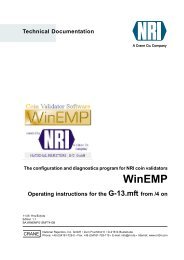G-13.mft parallel - NRI
G-13.mft parallel - NRI
G-13.mft parallel - NRI
You also want an ePaper? Increase the reach of your titles
YUMPU automatically turns print PDFs into web optimized ePapers that Google loves.
FUNCTION AND OPERATION G-<strong>13.mft</strong> totalizer<br />
Coin acceptance and coin channels<br />
For the purpose of coin acceptance, the totalizer possesses 32 "memory slots"<br />
that can be assigned up to 32 different coin types or tokens. These "memory<br />
slots" are termed coin channels. The acceptance band of a coin type/token is<br />
allocated to a coin channel and the coin type/token is accepted in that channel.<br />
To be able to reject false coins reliably, channels with a narrow or even a very<br />
narrow acceptance band are frequently set up for a coin type, in addition to the<br />
normal coin channel (see section "Label" in Chap. 3 "Design"). The limit<br />
values of these coin channels are closer to one another so that false coins with<br />
similar measured values are rejected, if the normal coin channel is inhibited<br />
(see section "Inhibit coins/activate narrow coin channel" in this chapter).<br />
Narrow and very narrow coin channels, however, also possess a lower<br />
acceptance rate.<br />
In addition, it is possible to allocate coins with different measured values but<br />
identical coin values to different coin channels. This is how the totalizer can,<br />
for example, accept old and new coins of the same type.<br />
However, a coin channel is not only assigned the acceptance band of a coin<br />
type but also other coin information which defines further processing of the<br />
coin after its acceptance: e.g. coin value, discount information or sorting<br />
information for an external sorting device.<br />
Since in most cases the manufacturer’s customer-specific programming<br />
does not take up all the coin channels, channels which are still vacant can<br />
be assigned coin types and the desired further information at any time using<br />
the configuration software. Existing configurations can be changed.<br />
The last eight coin channels 25 to 32 (or 9 to 16 with double block datamanagement,<br />
see section "Single or double block data-management" in<br />
this chapter) are intended to be used for the teach mode. In these coin<br />
channels new coin types can also be taught without configuration software,<br />
directly on the totalizer using the switching blocks; i.e. a coin channel is<br />
assigned a coin type or also a token (see section "Teach mode" in this<br />
chapter).<br />
18 National Rejectors, Inc. GmbH, Buxtehude
















